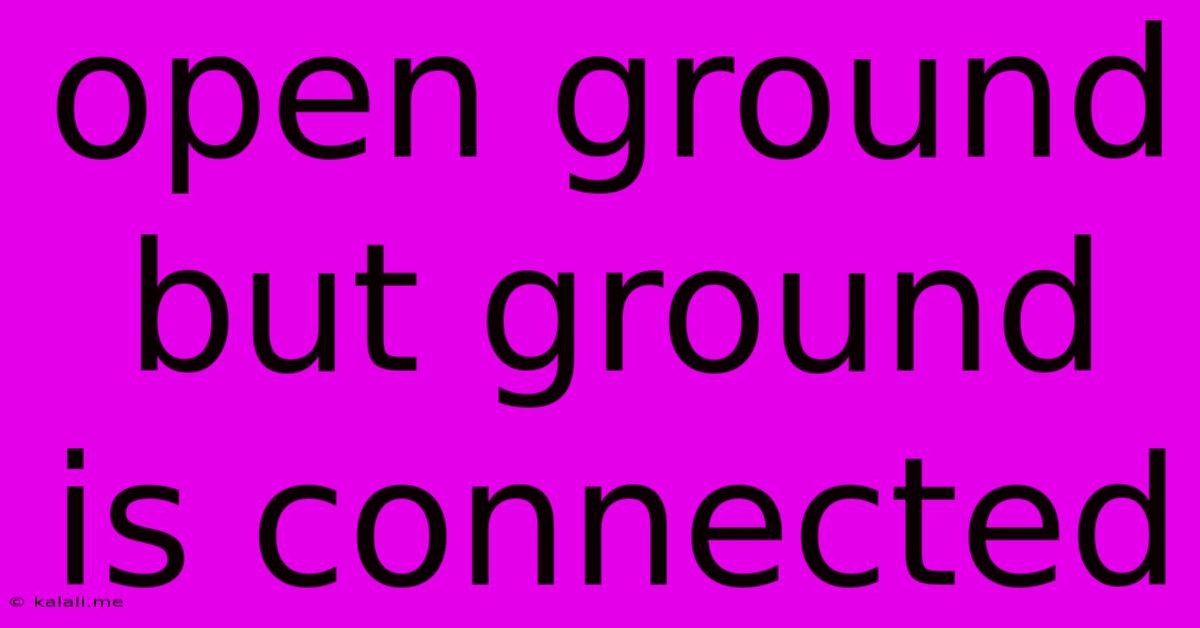Open Ground But Ground Is Connected
Kalali
May 23, 2025 · 4 min read

Table of Contents
Open Ground But Ground Is Connected: Understanding the Paradox of Networked Spaces
The concept of "open ground but ground is connected" might seem paradoxical at first glance. How can a space be both open and interconnected simultaneously? This seemingly contradictory idea describes a crucial aspect of modern networked environments, particularly in the digital realm, but also applicable to physical spaces. This article will explore this paradox, examining its implications across various contexts. We'll delve into the meaning of "open ground," the nature of "connected ground," and how their interplay shapes our experiences.
This article explores the intricate relationship between openness and connectivity in both digital and physical spaces. We will investigate how seemingly contradictory concepts can coexist and even enhance each other, shaping our interaction with the world around us. We will also discuss the implications of this dynamic interplay on various aspects of our lives.
What is "Open Ground"?
"Open ground" refers to a space characterized by freedom and accessibility. It's a place where information, ideas, and individuals can interact relatively freely, without significant barriers to entry or participation. Think of the early internet, a relatively open space where anyone could contribute and share. Similarly, open-source software projects represent open ground, allowing collaborative development and community contribution. In physical spaces, a public park or a town square could be considered examples of open ground. However, even within these ostensibly open spaces, certain unwritten rules and societal norms often subtly shape interactions.
Key characteristics of open ground include:
- Accessibility: Ease of entry and participation for a wide range of individuals.
- Freedom: Limited restrictions on expression, interaction, and information sharing.
- Decentralization: Lack of centralized control or authority.
- Inclusivity (Ideally): A welcoming environment for diverse perspectives and viewpoints.
The Nature of "Connected Ground"
While "open ground" emphasizes freedom and accessibility, "connected ground" highlights the interconnectedness within that space. This refers to the infrastructure, networks, and relationships that link elements within the open space. It's the underlying framework that facilitates communication, collaboration, and information flow. In the digital world, this could be the internet protocol (IP), social media platforms, or the various communication protocols that enable interaction. In physical spaces, roads, transportation networks, and communication infrastructure contribute to the connectedness of the ground.
Key aspects of connected ground include:
- Interconnectivity: The ability for different elements within the space to interact and exchange information.
- Infrastructure: The underlying systems and networks that enable connection.
- Relationships: The connections between individuals and groups within the space.
- Data Flow: The movement and exchange of information across the network.
The Interplay of Openness and Connectivity
The true power of "open ground but ground is connected" lies in the dynamic interplay between these two concepts. Openness fosters innovation, diversity, and creativity, while connectivity allows for collaboration, dissemination of information, and the formation of communities. However, this interplay isn't without its challenges. The very connectivity that enables collaboration can also facilitate the spread of misinformation, amplify biases, and create echo chambers. Similarly, the openness can be exploited, leading to abuse or the erosion of positive aspects of the open space.
Examples of this interplay in action:
- Online forums: Open for anyone to participate, yet connected through the platform's infrastructure and user interactions.
- Social media: A highly connected space, but the degree of openness can vary significantly depending on the platform and its moderation policies.
- Open-source software communities: Collaborative and open to contributions, but rely on strong communication networks and shared understanding.
Navigating the Challenges and Opportunities
Understanding the interplay of openness and connectivity is crucial for navigating the complex landscapes of both the digital and physical worlds. This requires careful consideration of how to maximize the benefits of openness while mitigating the risks associated with connectivity. This might involve developing robust moderation strategies, promoting media literacy, and fostering responsible online behavior. It also necessitates a critical awareness of the underlying infrastructure and its potential impact on freedom and inclusivity.
The concept of "open ground but ground is connected" is a powerful framework for understanding the dynamics of networked spaces. By appreciating both the opportunities and challenges inherent in this paradox, we can better navigate the increasingly interconnected world around us and work towards creating more equitable, inclusive, and beneficial environments.
Latest Posts
Latest Posts
-
Unlock Bootloader With Sp Flash Tool
May 23, 2025
-
How To Clean Mold In Shower
May 23, 2025
-
What Monitors Can I Use With Macbook Air M1
May 23, 2025
-
Minecraft Snow Falls On Stairs And Slabs
May 23, 2025
-
What Is An Ace In Tennis
May 23, 2025
Related Post
Thank you for visiting our website which covers about Open Ground But Ground Is Connected . We hope the information provided has been useful to you. Feel free to contact us if you have any questions or need further assistance. See you next time and don't miss to bookmark.